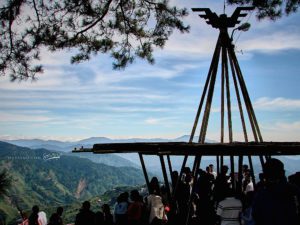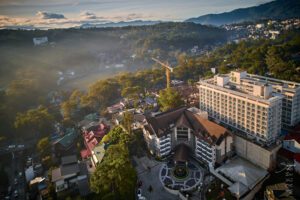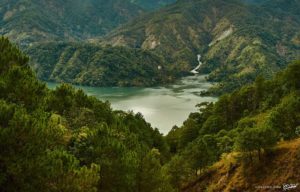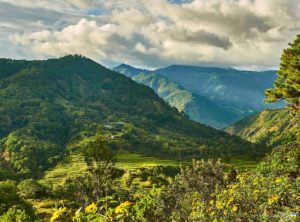
Dulche Chocolates: From Highland Cocoa Farms to Your Travel Treats
If you are planning a trip to the highlands of the Philippines, particularly around Baguio or Benguet, a visit to Dulche Chocolates offers a uniquely
Situated in the heart of Baguio City, the Our Lady of Atonement Cathedral—more popularly known as Baguio Cathedral—stands as a masterpiece of neo-Romanesque architecture and a symbol of resilience and devotion. With its striking rose-colored facade, twin spires, and intricate stained-glass windows, the cathedral is not only a place of worship but also a historical and cultural treasure that captivates visitors from near and far.

ABOVE: The Baguio Cathedral serves as both a sacred place of worship and a remarkable symbol of Baguio City’s rich history and cultural heritage. It continues to captivate locals and tourists alike, offering a peaceful sanctuary and an opportunity to experience the city’s timeless beauty.
ABOVE: The Baguio Cathedral serves as both a sacred place of worship and a remarkable symbol of Baguio City’s rich history and cultural heritage. It continues to captivate locals and tourists alike, offering a peaceful sanctuary and an opportunity to experience the city’s timeless beauty.
The origins of Baguio Cathedral trace back to 1907 when Belgian missionaries from the Congregatio Immaculati Cordis Mariae (CICM) established a Catholic mission chapel dedicated to St. Patrick. Originally called “Kampo” by the indigenous Ibaloi people, the site was later renamed Mount Mary by Fr. Florimund Carlu, who led the construction of the cathedral in 1920. The project reached completion in 1936, when the church was consecrated in honor of Our Lady of Atonement.
During World War II, Baguio Cathedral became a sanctuary for civilians, offering refuge during the American carpet-bombing of the city on March 15, 1945. Unlike much of Baguio, the cathedral survived the devastation, and the remains of those who perished are interred within its grounds—making it not only a religious landmark but also a poignant reminder of history and resilience.
Baguio Cathedral’s neo-Romanesque design is truly a sight to behold. The facade is adorned with a majestic rose window, while its twin belfries, capped with pyramidal roofs, stand tall against the Baguio skyline. Inside, the spacious interior can accommodate up to 850 worshippers, with additional external areas equipped with loudspeakers for overflow crowds, particularly on Sundays.
A visit to Baguio Cathedral is made even more enchanting by its elevated location, offering stunning views of the city. Visitors can reach the cathedral by ascending a scenic 104-step stone staircase from Session Road, which culminates at a Calvary. Alternatively, access roads behind the Baguio Post Office provide a more convenient route for those traveling by car. The cathedral’s courtyard also features a viewing deck, offering a breathtaking panorama of Baguio’s vibrant cityscape.

ABOVE: This captivating space reflects its enduring purpose as a sanctuary for the growing community of worshippers and visitors in Baguio City, making it a must-see destination for those seeking serenity and architectural elegance.
ABOVE: This captivating space reflects its enduring purpose as a sanctuary for the growing community of worshippers and visitors in Baguio City, making it a must-see destination for those seeking serenity and architectural elegance.
More than just an architectural wonder, Baguio Cathedral holds deep spiritual significance as the seat of the Roman Catholic Diocese of Baguio. It remains a focal point for religious celebrations, attracting both the faithful and curious tourists alike. The cathedral’s endurance through wartime adversity has only strengthened its place in the hearts of Baguio’s residents, symbolizing faith, hope, and perseverance.


ABOVE: Baguio Cathedral, or Our Lady of the Atonement Cathedral, is a well-known landmark in Baguio City, famous for its twin spires, rose-colored façade, and beautiful views of the city.
ABOVE: Baguio Cathedral, or Our Lady of the Atonement Cathedral, is a well-known landmark in Baguio City, famous for its twin spires, rose-colored façade, and beautiful views of the city.
Baguio Cathedral is conveniently located at Cathedral Loop, adjacent to the bustling Session Road. It is easily accessible by foot, taxi, or jeepney from various points in the city. The cathedral hosts multiple Mass services throughout the week, though schedules may vary. Visitors are encouraged to check the latest Mass timings or any updates by contacting the cathedral administration at +63 74 304 4061 or through their official Facebook page.
Whether you’re seeking a place of prayer, a glimpse into history, or a stunning architectural marvel, Baguio Cathedral is a destination that promises an enriching experience. Its breathtaking design, rich historical narrative, and panoramic city views make it a must-visit landmark in Baguio City. So, the next time you find yourself in the City of Pines, don’t miss the opportunity to step inside this timeless sanctuary and immerse yourself in its beauty and heritage.
RELATED STORIES

If you are planning a trip to the highlands of the Philippines, particularly around Baguio or Benguet, a visit to Dulche Chocolates offers a uniquely



Originally known as the Baguio Flower Festival, the Panagbenga Festival is a month-long annual flower festival held every February in Baguio City, that celebrates and



Travelers wandering through the cool, pine-scented corners of Baguio often search for places that blend good food, local creativity, and that distinct highland charm the



For many people, it has always been a dream to visit a place that offers a breathtaking view surrounded by a natural atmosphere that is
I’m looking forward to the stories and images leaving a lasting positive impression on you, just as they have on me. Stay connected with us on social media for a weekly exploration of travel assignments and breathtaking visuals. Our focus is on championing local tourism, showcasing small businesses, and honoring the magnificence of the Philippines through the content we curate. Join us in spreading the word by clicking the ‘share’ buttons below. Your support means the world to us.
EXPLORE MORE about


Baguio City, the Summer Capital of the Philippines, has long been celebrated for its vibrant art scene and rich cultural heritage. In 2025, the Ibagiw


Azalea Residences Baguio welcomes travelers with the perfect balance of comfort, convenience, and modern design in the heart of the City of Pines. Nestled along



For many people, it has always been a dream to visit a place that offers a breathtaking view surrounded by a natural atmosphere that is


When you think of Baguio, you imagine pine‑scented breezes, foggy mornings, and cozy cafés tucked into the city’s winding streets. Among these, Guest Haven Coffee


As a popular festival that originated in Dolores in the Province of Abra, Sakuting Festival depicts a mock battle using sticks, usually striped or bamboo.


Le Coq Bleu Baguio is a welcoming space where comfort meets creativity. Owned by Chantal Michaut-Pangilinan, a Frenchwoman who has lived in the city for


Baguio Media Newseum, also known as the Art World & Media Newseum, offers travelers a unique experience beyond the familiar pine forests and scenic viewpoints


Amid the cool mountain air and pine-scented streets of Baguio City, there is a place where the warmth of a crackling wood-fired oven meets the



If you are planning a trip to the highlands of the Philippines, particularly around Baguio or Benguet, a visit to Dulche Chocolates offers a uniquely



Originally known as the Baguio Flower Festival, the Panagbenga Festival is a month-long annual flower festival held every February in Baguio City, that celebrates and


It is one of the country’s oldest and largest hydroelectric power plants, the Ambuklao Dam is the largest hydroelectric plant built today in the country.


The Mount Pulag is considered as the highest mountain in Luzon Island and it sits on the border of three provinces entwined at its summit.


Perched along Marcos Highway inside The Podium Boutique Hotel, Hoka Brew welcomes visitors with a warm, wood-themed interior and wide windows framing the lush, pine-covered


Kabayan of the Benguet Province is probably best known for its position as a base camp for Mount Pulag which is the highest mountain on



Travelers wandering through the cool, pine-scented corners of Baguio often search for places that blend good food, local creativity, and that distinct highland charm the
BROWSE BY CATEGORIES